
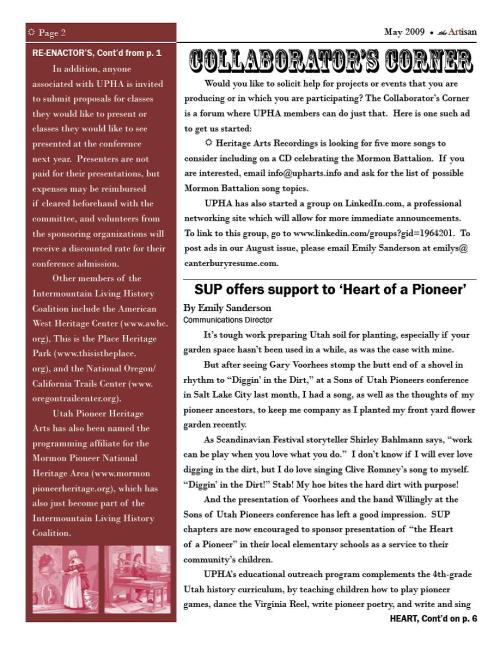
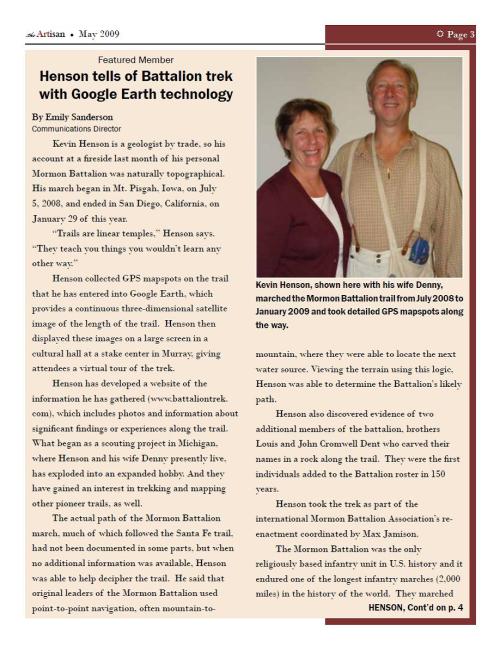
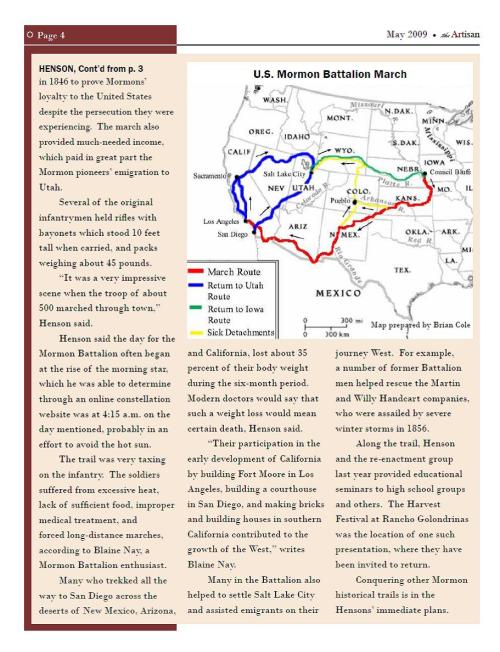
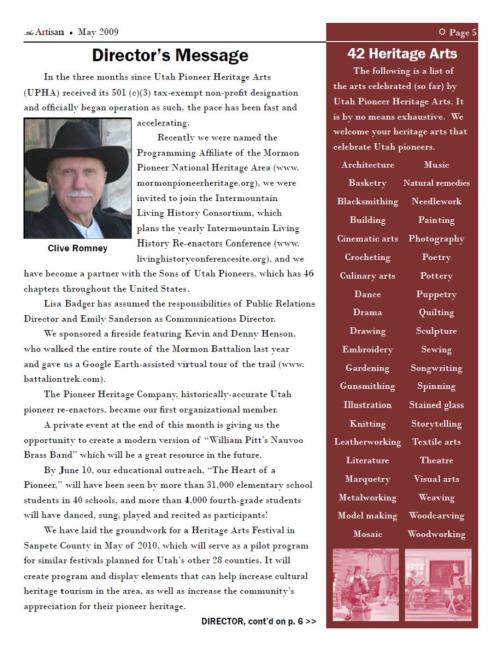
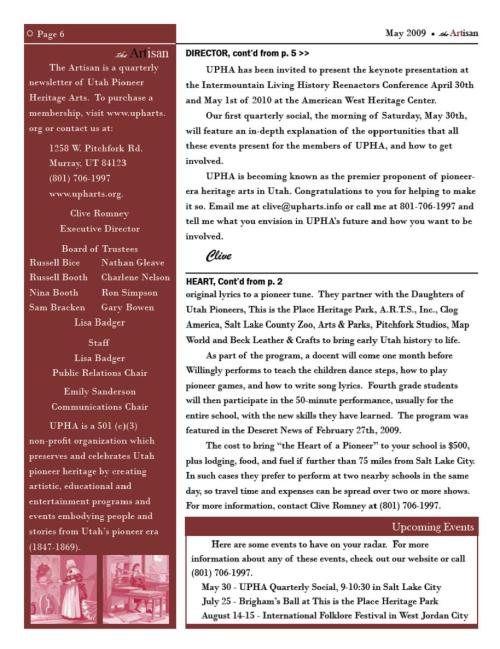
Archive for May, 2009
UPHA May 2009 Newsletter
Posted in Utah Pioneer Heritage Arts on May 29, 2009| Leave a Comment »
Featured Member: Henson tells of Battalion trek with Google Earth technology
Posted in Utah Pioneer Heritage Arts on May 29, 2009| Leave a Comment »
By Emily Sanderson — May 2009
Kevin Henson is a geologist by trade, so his account at a fireside last month of his personal Mormon Battalion was naturally topographical. His march began in Mt. Pisgah, Iowa, on July 5, 2008, and ended in San Diego, California, on January 29 of this year.
“Trails are linear temples,” Henson says. “They teach you things you wouldn’t learn any other way.”
Henson collected GPS mapspots on the trail that he has entered into Google Earth, which provides a continuous three-dimensional satellite image of the length of the trail. Henson then displayed these images on a large screen in a cultural hall at a stake center in Murray, giving attendees a virtual tour of the trek.
Henson has developed a website of the information he has gathered (www.battaliontrek.com), which includes photos and information about significant findings or experiences along the trail. What began as a scouting project in Michigan, where Henson and his wife Denny presently live, has exploded into an expanded hobby. And they have gained an interest in trekking and mapping other pioneer trails, as well.
The actual path of the Mormon Battalion march, much of which followed the Santa Fe trail, has not been documented in some parts, but when no additional information was available, Henson was able to help decipher the trail. He said that original leaders of the Mormon Battalion used point-to-point navigation, often mountain-to-mountain, where they were able to locate the next water source. Viewing the terrain using this logic, Henson was able to determine the Battalion’s likely path.
Henson also discovered evidence of two additional members of the battalion, brothers Louis and John Cromwell Dent who carved their named in a rock along the trail. They were the first individuals added to the Battalion roster in 150 years.
Henson took the trek as part of the international Mormon Battalion Association’s re-enactment coordinated by Max Jamison.
The Mormon Battalion was the only religiously based infantry unit in U.S. history and it endured one of the longest infantry marches (2,000 miles) in the history of the world. They marched in 1846 to prove Mormon’s loyalty to the United States despite the persecution they were experiencing. The march also provided much-needed income, which paid in great part the Mormon pioneers’ emigration to Utah.
Several of the original infantrymen held rifles with bayonets which stood 10 feet tall when carried, and packs weighing about 45 pounds.
“It was a very impressive scene when the troop of about 500 marched through town,” Henson said.
Henson said the day for the Mormon Battalion often began at the rise of the morning star, which he was able to determine through an online constellation website was at 4:15 a.m. on the day mentioned, probably in an effort to avoid the hot sun.
The trail was very taxing on the infantry. The soldiers suffered from excessive heat, lack of sufficient food, improper medical treatment, and forced long-distance marches, according to Blaine Nay, a Mormon Battalion enthusiast.
Many who trekked all the way to San Diego across the deserts of New Mexico, Arizona and California lost about 35 percent of their body weight during the six-month period. Modern doctors would say that such a weight loss would mean certain death, Henson said.
“Their participation in the early development of California by building Fort Moore in Los Angeles, building a courthouse in San Diego, and making bricks and building houses in southern California contributed to the growth of the West,” writes Nay.
Many in the Battalion also helped settle Salt Lake City and assisted emigrants on their journey West. For example, a number of former Battalion men helped rescue the Martin and Willy Handcart companies, who were assailed by severe winter storms in 1856.
Along the trail, Henson and the re-enactment group last year provided educational seminars to high school groups and others. The Harvest Festival at Rancho Golondrinas was the location of one such presentation, where they have been invited to return.
Conquering other Mormon historical trails is in the Hensons’ immediate plans, Henson said.
Upcoming Events
Posted in Utah Pioneer Heritage Arts on May 29, 2009| Leave a Comment »
May 2009
Here are some events to have on your radar. For more information about any of these events, check out our website or call (801) 706-1997.
May 30 – UPHA Quarterly Social, 9-10:30 a.m. in Salt Lake City
July 25 – Brigham’s Ball at This is the Place Heritage Park
August 14-15 – International Folklore Festival in West Jordan City
SUP offers support to ‘Heart of a Pioneer’
Posted in Utah Pioneer Heritage Arts on May 29, 2009| Leave a Comment »
By Emily Sanderson — May 2009
It’s tough work preparing Utah soil for planting, especially if your garden space hasn’t been used in a while, as was the case with mine.
But after seeing Gary Voorhees stomp the butt end of a shovel in rhythm to “Diggin’ in the Dirt,” at a Sons of Utah Pioneers conference in Salt Lake City last month, I had a song, as well as the thoughts of my pioneer ancestors, to keep me company as I planted my front yard flower garden recently.
As Scandinavian Festival storyteller Shirley Bahlmann says, “work can be play when you love what you do.” I don’t know if I will ever love digging in the dirt, but I do love singing Clive Romney’s song to myself. “Diggin’ in the Dirt!” Stab! My hoe bites the hard dirt with purpose!
And the presentation of Voorhees and the band Willingly at the Sons of Utah Pioneers conference has left a good impression. SUP chapters are now encouraged to sponsor presentations of “the Heart of a Pioneer” in their local elementary schools as a service to their community’s children.
UPHA’s educational outreach program complements the 4th-grade Utah history curriculum by teaching children how to play pioneer games, dance the Virginia Reel, write pioneer poetry, and write and sing original lyrics to a pioneer tune. They partner with the Daughters of Utah Pioneers, This is the Place Heritage Park, A.R.T.S. Inc., Clog America, Salt Lake County Zoo, Arts and Parks, Pitchfork Studios, Map World and Beck Leather & Crafts to bring early Utah history to life.
As part of the program, a docent will come one month before Willingly to prepare fourth graders to participate in the 50-minute performance, usually for the entire school, with the new skills they have learned. The program was featured in the Deseret News on February 27, 2009.
The cost to bring “the Heart of a Pioneer” to your school is $500, plus lodging, food, and fuel if further than 75 miles from Salt Lake City. In such cases they prefer to perform at two nearby schools in the same day, so travel time and expenses can be spread over two or more shows. For more information, contact Clive Romney at (801) 706-1997.
Collaborator’s Corner
Posted in Utah Pioneer Heritage Arts on May 29, 2009| Leave a Comment »
May 2009
Would you like to solicit help for projects or events that you are producing or in which you are participating? The Collaborator’s Corner is a forum where UPHA members can do just that. Here is one such ad to get us started:
Heritage Arts Recordings is looking for five more songs to consider including on a CD celebrating the Mormon Battalion. If you are interested, email info@upharts.info and ask for the list of possible Mormon Battalion song topics.
UPHA has also started a group on LinkedIn.com, a professional networking site which will allow for more immediate announcements. To link to this group, go to http://www.linkedin.com/groups?gid=1964201. To post ads in our August issue, please email Emily Sanderson at emilys@canterburyresume.com
UPHA Quarterly Social
Posted in Utah Pioneer Heritage Arts on May 29, 2009| 1 Comment »
Join with other members of the Utah Pioneer Heritage Arts for the first quarterly breakfast social Saturday, May 30.
The socials include a live presentation by one member of or about their art. An open forum follows to promote collaboration. Clive Romney will provide the presentation for his first social. He will discuss our opportunity with the 2010 Intermountain Living History Re-enactor’s Conference.
The social is a fun, informal way to get to know other members and their art. The social will be held at the home of Lisa Badger and Robert Wood, 2639 S. 1900 East, from 9-10 a.m. and will include a waffle breakfast. Contact Lisa at (801) 897-7067 if you’d like to bring fresh fruit, milk, or waffle toppings.
UPHA members to present arts’ power, value in 2010
Posted in Utah Pioneer Heritage Arts on May 29, 2009| Leave a Comment »
May 2009
Utah Pioneer Heritage Arts members have an opportunity to develop and produce a presentation at the Fourth Annual Intermountain Living History Re-enactor’s Conference, tentatively slated for April 30-May 1, 2010 at the American West Heritage Center in Wellsville near Logan.
The project came as a result of UPHA’s invitation to join the Intermountain Living History Coalition which plans the Living History Re-enactor’s Conference each year.
The theme of the presentation in 2010 is the value and power of the arts in historical interpretation with an emphasis in pioneer arts, such as woodworking, embroidery, puppetry, textile arts, storytelling, and dance.
Clive Romney, Executive Director of UPHA, was asked to present the keynote address at the conference, and he offered instead to provide this presentation.
David Sidwell, program director for the American West Heritage Center, suggested that AWHC produce a period play, such as was presented in many pioneer towns, at the Friday night Dutch over dinner and dance.
The Pioneer Christmas that Pioneer Heritage Company (www.pioneerheritagecompany.com) presented at the Museum of Church History December 6 of last year was a great example of the value and power of arts in historical interpretation.
In addition, anyone associated with UPHA is invited to submit proposals for classes they would like to present or classes they would like to see presented at the conference next year. Presenters are not paid for their presentations, but expenses may be reimbursed if cleared beforehand with the committee, and volunteers from the sponsoring organizations will receive a discounted rate for their conference admission.
Other members of the Intermountain Living History Coalition include the American West Heritage Center (www.awhc.org), This is the Place Heritage Park (www.thisistheplace.org), and the National Oregon/California Trails Center (www.oregontrailcenter.org).
Utah Pioneer Heritage Arts has also been named the programming affiliate for the Mormon Pioneer National Heritage Area (www.mormonpioneerheritage.org), which has also just become part of the Intermountain Living History Coalition.
Festival offered speakers, bread, quilts, Viking lore and more
Posted in Sanpete Messenger on May 28, 2009| Leave a Comment »
EPHRAIM — Thousands attended the 33rd annual Scandinavian Heritage Festival last Thursday through Saturday.
At the Heritage Conference, Clive Romney, an acclaimed musician and executive director of the Utah Pioneer Heritage Arts organization, spoke on not letting our ancestors be forgotten.
He explained how art can help preserve family heritages. Art, whether it be written, visual, oral or musical, makes stories fun to tell and encourages repetition so that family members are more likely to remember.
“There are stories in your family that need to be told,” Romney said.
In the Festival’s breadmaking contest, Jenny Frame won the grand prize for her beautiful braided cardamom bread. Cardamom is a sweet spice that is similar to cinnamon.
First place for a Scandinavian bread went to Christine Ashcroft for her Norwegian jule kaga that included raisins and citron. Second place for a Scandinavian bread went to Suzanne Freeman for a rye bread with raisins (and included chocolate as a secret ingredient).
A new favorite at the storytelling tent is the Messenger’s very own John Hales. Hales told stories of Scandinavian folklore, including one on a beastly giant with no heart and another as to why the ocean is salty.
Quilt-makers of all levels showcased quilts in the Ephraim Co-op. Entries included pieced and appliqued works that were both machine- and hand-quilted. Quilts on display came in all sizes and included traditional designs as well as artistic renditions of landscapes and objects.
Roger Baker provided bus tours of Ephraim. Sites included a tour of the old pioneer cemetery north of town, Pioneer Park, the Co-op and some of the first homes built. Baker pointed out the frequent use of oolite sandstone for exteriors or for just the foundations of structures. He also told stories of the Blackhawk War and of early Danish settlers.
The owners of the recently restored home of Canute Peterson, the first LDS stake president in Ephraim, opened their home for tours Saturday, as did a number of homeowners of older homes in town.
A welcome addition to the music lineup at this year’s Festival was the band Caboose, which performed with fellow artists in the “Roundhouse.”
Caboose includes acoustic, bluegrass, Celtic and swing styles and features solos of rare, older instruments including the mandolin, penny whistle, ocarina and melodica.
Caboose shared the stage with artists that composed and performed songs on an album called The Ghosts of Gardner Village, including Nancy Hanson, Sam Payne, Tammy Robinson and Clive Romney.
Other performing bands including Lincoln Highway, Firefly and the Phat Old Professors.
Mexico’s flag won’t fly at cemetery
Posted in Sanpete Messenger on May 21, 2009| Leave a Comment »
EPHRAIM — Ephraim City will not hang a Mexican flag along with other “heritage” flags that fly over the city’s cemetery.
At a meeting last week, the Ephraim City Cemetery Board declined a proposal to fly a Mexican flag. The request had been made by several Hispanic residents and students, with the help of Snow College faculty member English Brooks.
The board agreed, however, that the local Hispanic population needed more representation in the city government. They encouraged the city council to include a person of Hispanic descent on a new committee that would manage Heritage Park south of town on 100 East, where there are plans to fly national flags — including a Mexican flag — to represent the city’s population.
Including a person of Hispanic descent on the committee would open the door for the inclusion of Hispanics on other future committees, said Beverly Thomas, cemetery board chair.
Caboose, Ghosts of Gardner Village bring it home
Posted in Uncategorized on May 21, 2009| Leave a Comment »
By Emily Sanderson
Expect some world class entertainment from Caboose and the Ghosts of Gardner Village at the Scandinavian Heritage Festival this weekend.
Caboose includes acoustic, bluegrass, Celtic and swing styles and features solos of rare, older instruments including the mandolin, penny whistle, ocarina and melodica. I had to google a few of those to know what they were, and even if you don’t recognize their sounds this weekend, you will want to hear the instruments again. Combine these with the thump-thump-thump of a string bass, toe-tapping percussion and strong lyrics. Caboose is a step above the BYU jazz and Celtic concerts, which are often sold out.
Band members, a few of whom are university-level instructors, include Daron Bradford, Rob Honey, Tom Hewitson, Deborah Grimshaw and Clive Romney. These musicians live and breathe rhythm, and they have a lot of fun creating original works together.
This weekend, Caboose will share the stage with artists that composed and performed songs on The Ghosts of Gardner Village album, including Nancy Hanson, Sam Payne, Tammy Robinson and Clive Romney.
In “The Escape of Archibald Gardner,” Payne shares the plight of a man who must leave his wife and infant child in Canada to save his own life. Robinson, in “My Baby Lives,” tells of an Indian woman who, despite of misgivings, collaborates with a pioneer woman to help prevent an Indian war.
My favorite song on the album is “Diggin’ in the Dirt,” the percussion of which involves the stomping and clanging together of your garden-variety shovels and hoes. With that song in my head, planting my flower garden this month in some of the same dirt as that of my ancestors made me feel connected to those who came before me.
I love the music I listen to, many of the bands having electronic and synthesized sounds. But hearing Caboose and the Ghosts of Gardner Village with their highly skilled playing of diverse and authentic instruments fills my soul with rich, pure music. These bands are must-sees for every guitar and violin student.